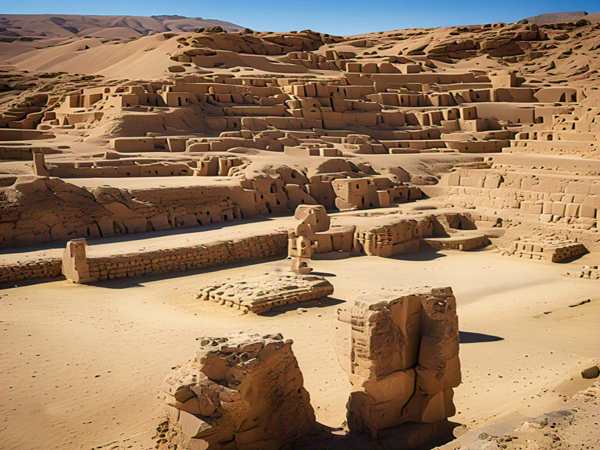Uncovering Peru’s Pyramid Legacy: The Hidden Wonders of Lambayeque Valley
Peru is emerging as the new capital of the pyramid world, thanks to its treasure trove of ancient structures. While Egypt may be famous for its pyramids, Peru boasts its own collection of mysterious and majestic pyramid complexes, including Caral, the oldest known pyramid in the world. With every new archaeological dig, more of these awe-inspiring structures are uncovered, revealing a rich history that spans thousands of years.
One of the most fascinating areas of discovery is the Lambayeque Valley, a region filled with both natural and man-made waterways and home to a staggering number of pyramids. Locals refer to this area as Purgatorio, or purgatory, due to the abundance of ancient ruins, enclosures, and mounds found around La Raya Mountain, south of the La Leche River. This region contains three pyramid cities, each built in succession and abandoned before the next was constructed. Collectively, these cities contain a mind-boggling 250 pyramids.
The Pyramid Cities of Lambayeque Valley
The first of the three pyramid cities is Pampa Grande, constructed between 600 and 750 AD. Among the pyramids here is Huaca Fortaleza, which stands at an impressive 50 meters high and spans 200 meters in width. While much of the structure remains intact, it has lost some of its visual grandeur over the centuries. Nevertheless, its historical significance is undeniable.
The next pyramid complex is Batan Grande, built between 750 and 1100 AD. This city once had 34 pyramids, including the famous Huaca de Oro, or Pyramid of Gold, where royal tombs were located. Unfortunately, the site suffered significant damage during the El Niño rains of 1982 and 1998, leaving many of the pyramids badly eroded. However, the most significant destruction was man-made, when the city was burned and abandoned around 1100 AD.
The final pyramid city, Túcume, was constructed around 1100 AD and remained inhabited until 1500 AD. This vast site covers over 540 acres and contains 26 major pyramids and platforms. The people of Túcume saw these pyramids as symbolic mountains, meant to invoke the power of the gods and the forces of nature. Even today, local shamans continue to honor these ancient traditions, using the pyramids as spiritual sites.
The Sacred Legends of Túcume
Túcume is steeped in legend and lore. One of the most famous stories, recorded by Father Cabello de Balboa in 1586, tells of Cala, a grandson of Naymlap, the founder of the Lambayeque royal dynasty. According to the legend, Cala declared that Túcume would become the new metropolis for his people after he was exiled from Batan Grande.
The construction of the Taymi irrigation canal, which stretches over 43 miles from the Chancay River, was a crucial development for the region. This canal transformed the surrounding land into fertile agricultural territory, ensuring the prosperity of Túcume. Today, modern Túcume is located just 17 miles north of Chiclayo and continues to preserve its ancient heritage, including the pre-Hispanic village pyramid Huaca del Pueblo.
Exploring the Pyramids of Túcume
The most impressive pyramids of Túcume are located in the monumental sector to the north and northeast of La Raya Mountain, also known as the “Mountain of the Ray.” Archaeological investigations in this area, including work by famed Norwegian explorer Thor Heyerdahl, have focused on three major structures: Huaca Larga, Huaca 1, and the U-shaped Temple of the Sacred Stone.
The Temple of the Sacred Stone is a small, rectangular structure that played a significant role in the religious life of Túcume. Travelers passing through the Lambayeque Valley would stop at this temple before entering the main city. The temple’s central feature is a large, upright boulder, which may have been an object of worship or spiritual significance. Surrounding the temple, archaeologists have uncovered numerous offerings, including valuable Spondylus shells, slaughtered llamas, and intricate sheet-metal miniatures representing various themes, from flora and fauna to musical instruments.
The discovery of these offerings provides insight into the religious practices of the people of Túcume. Similar offerings, including human sacrifices, have been found at other major Inca shrines across Peru. One notable example is the discovery of the mummy of an Inca girl, known as Juanita, at the top of the snow-capped Ampato Mountain in southern Peru. These findings highlight the deep connection between the people of Túcume and their gods, as well as the importance of ritual and sacrifice in their society.
The Future of Túcume: Preserving Peru’s Pyramid Legacy
In recent years, the Túcume area has attracted increasing attention from both archaeologists and tourists. Recognizing the site’s cultural and historical importance, the Peruvian government has slated Túcume for tourism development. However, this growth has sparked concerns about the preservation of the fragile and eroding remains of the pyramids.
The site’s listing in 2004 brought in significant private-sector support for preservation efforts, but a long-term conservation plan has yet to be established. As tourism continues to expand, it is crucial to strike a balance between development and the protection of these ancient structures, ensuring that future generations can appreciate the rich history of the Lambayeque Valley.
Conclusion: Peru’s Pyramid World Awaits Discovery
As more and more pyramids are uncovered in Peru, the country’s role as a global center of ancient pyramid culture becomes increasingly apparent. The Lambayeque Valley, with its three pyramid cities and hundreds of structures, offers a fascinating glimpse into the past. The stories of these pyramids, the people who built them, and the legends that surround them continue to captivate the imagination of archaeologists, historians, and visitors alike.
Peru’s pyramid world is not just a relic of the past; it is a living, breathing testament to the ingenuity and spiritual depth of its ancient civilizations. As we continue to explore and uncover these wonders, we are reminded of the incredible legacy left behind by the people of Túcume and the Lambayeque Valley. So, if you’re seeking a journey through history, mystery, and awe-inspiring architecture, look no further than Peru’s pyramids.

